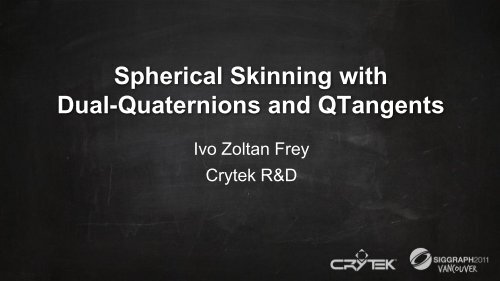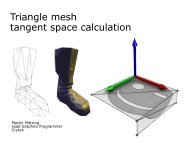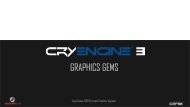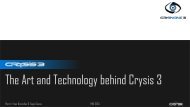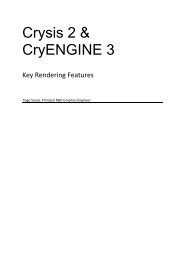Spherical Skinning with Dual-Quaternions and QTangent - Crytek
Spherical Skinning with Dual-Quaternions and QTangent - Crytek
Spherical Skinning with Dual-Quaternions and QTangent - Crytek
Create successful ePaper yourself
Turn your PDF publications into a flip-book with our unique Google optimized e-Paper software.
<strong>Spherical</strong> <strong>Skinning</strong> <strong>with</strong><strong>Dual</strong>-<strong>Quaternions</strong> <strong>and</strong> <strong>QTangent</strong>sIvo Zoltan Frey<strong>Crytek</strong> R&D
Goals#1 Improve performance by reducing the shaderconstant requirements for joint transformations30% shader constants reduction#2 Reduce the memory foot-print ofskinned geometry22% vertex memory reduction29% for static geometry
Skinned Geometry
Goal #1• Improve performance by reducing the shaderconstant requirements for joint transformations• Skinned geometry requires multiple passes• Motion Blur requires twice the transformations• The amount of required shader constantsaffects the performance of a single pass
<strong>Skinning</strong> <strong>with</strong> <strong>Quaternions</strong>• ~30% less shader constants consumptioncompared to 4x3 packed matrices• Quaternion Linear <strong>Skinning</strong>• Accumulated transformations don’t work for positions• Explosion of vertex instructions• Quaternion <strong>Spherical</strong> <strong>Skinning</strong> [HEIJL04]• Extra vertex attribute required• Doesn’t h<strong>and</strong>le well more than 2 influences per vertex• <strong>Dual</strong>-Quaternion <strong>Skinning</strong> [KCO06] [KCZO08]• Increase in vertex instructions
<strong>Dual</strong>-Quaternion <strong>Skinning</strong> [KSO06] [KCZO08]• Compared to Linear <strong>Skinning</strong> <strong>with</strong> matrices• Accumulation of transformations is faster• Applying the transformation is slower• With enough influences per vertex it becomes overall faster• The reduction of shader constants was awin over the extra vertex instructions cost
From Linear to <strong>Spherical</strong>• Geometry needs to be rigged differently• And you will still need your helper joints• Riggers <strong>and</strong> Animators need to get used to it• Some will love it, others will hate itMost will keep changing their mind• You might have to write skinning plug-insfor third party authoring software• Some recent authoring packages have adopted<strong>Dual</strong>-Quaternion <strong>Skinning</strong> out of the box
Goal #2• Reduce the memory foot-print ofskinned geometry• We are now developing on consoles, every byte counts!• More compact vertex format will also lead tobetter performance• Do not sacrifice quality in the process!
Tangent FramesTangent Frames were the biggest vertex attributeafter our trivial memory optimizationsIn further optimizing them we need to ensure that• They keep begin efficiently transformed by <strong>Dual</strong>-<strong>Quaternions</strong>• All our Normal Maps keep working as they are
About Tangent Frames• Please make them orthogonal!• If they are not, you are introducing skewing• You can’t use a transpose to invert the frame matrix• You need a full matrix inversion• This will also prevent you from using somecompression techniques!
Compressed Matrix FormatVertex attributes contain two of theframe’s vectors <strong>and</strong> a reflection scalarTangent BiTangent Reflectionx y z x y z sThe third frame’s vector is rebuild from a crossproduct of the given vectors <strong>and</strong> a multiplication<strong>with</strong> the reflection scalarnormal = cross(tangent, biTangent) * s
Tangent Frames With <strong>Quaternions</strong>Quaternion to Matrix conversiont = transform(q, vec3(1, 0, 0))b = transform(q, vec3(0, 1, 0))n = transform(q, vec3(0, 0, 1))<strong>Quaternions</strong> don’t natively containreflection information
Bringing Reflection Into the EquationSimilarly to the compressed matrixformat, we can introduce reflection<strong>with</strong> a scalar valuet = transform(q, vec3(1, 0, 0))b = transform(q, vec3(0, 1, 0))n = transform(q, vec3(0, 0, 1)) * s
Tangent Frame Format Memory ComparisonCompressed MatrixTangent BiTangent Reflectionx y z x y z sQuaternionQuaternion Reflectionx y z w s75
Our Quaternion PropertiesThey are normalizedlength(q) == 1And they are sign invariantq == -q
Quaternion CompressionWe can compress a Quaternion down to three elements bymaking sure one of the them is greater than or equal to zeroif (q.w < 0)q = -qWe can then rebuild the missing element <strong>with</strong>q.w = sqrt(1 – dot(q.xyz , q.xyz))
Tangent Frame Format Memory ComparisonCompressed MatrixTangent BiTangent Reflectionx y z x y z sQuaternionQuaternion Reflectionx y z w s754Compressed QuaternionQuaternion Reflectionx y z s
Instruction CostQuaternion decompression5 mov, dp3, add, rsq, rcpQuaternion to Tangent <strong>and</strong> BiTangent6 add, mul, mad, mad, mad, madNormal <strong>and</strong> Reflection computation3 mul, mad, mulTotal11 for Tangent, BiTangent <strong>and</strong> Reflection14 for full Tangent Frame
Avoiding Quaternion CompressionIsn't there a way to encode the reflection scalarin the Quaternion, instead of compressing it?Remember, <strong>Quaternions</strong> are sign invariantq == -qWe can arbitrarily decide whether one of itselements has to be negative or positive!
Encoding ReflectionFirst we initialize the Quaternionby making sure q.w is always positiveif (q.w < 0)q = -qIf then we require reflection, we make q.w negativeby negating the entire Quaternionif (reflection < 0)q = -q
Decoding ReflectionAll we have to do in order to decode our reflection scalaris to check for the sign of q.wreflection = q.w < 0 ? -1 : +1As for the Quaternion itself, we can use it as it is!q = q
Instruction CostReflection decoding2 slt, madQuaternion to Tangent <strong>and</strong> BiTangent6 add, mul, mad, mad, mad, madNormal <strong>and</strong> Reflection computation3 mul, mad, mulTotal8 for Tangent, BiTangent <strong>and</strong> Reflection11 for full Tangent Frame
Tangent Frame Transformation <strong>with</strong> <strong>Dual</strong>-QuaternionQuaternion-Vector transformationQuaternion-Quaternion transformation|| float3x3 frame;6 | frame[0] = transform_quat_vec(| skinningQuat, vertex.tangent.xyz);|6 | frame[1] = transform_quat_vec(| skinningQuat, vertex.biTangent.xyz);|2 | frame[2] = cross(frame[0], frame[1]);1 | frame[2] *= vertex.tangent.w;|15 instructions|5 | float4 q = transform_quat_quat(| skinningQuat, vertex.qTangent)|8 | float3x3 frame = quat_to_mat(q);|3 | frame[2] *= vertex.qTangent.w < 0 ? -1 : +1;||||16 instructions
<strong>QTangent</strong> DefinitionA Quaternion of which the sign ofthe scalar element encodes the Reflection
Stress-Testing <strong>QTangent</strong>sBy making sure we throw at itour most complex geometry!
Singularity Found!
Singularity Found!At times the most complex cases pass,while the simplest fail!
SingularityOur singularities manifest themselves when theQuaternion’s scalar element is equal to zeroMatrix-1, 0, 0 Quaternion0, -1, 0 0, 0, 1, 00, 0, 1This means the Tangent Frame’s surface isperpendicular to one of the identity’s axis
Floating-Point St<strong>and</strong>ards• So what happens when theQuaternion’s scalar element is 0?• The IEEE St<strong>and</strong>ard for Floating-Point Arithmetic doesdifferentiate between -0 <strong>and</strong> +0, so we should be fine!• However GPUs don’t exactly always comply to thisst<strong>and</strong>ard, at times for good reasons
GPUs Floating-Point “St<strong>and</strong>ards”• GPUs allow vertex attributes to be specified asintegers representing normalized unit scalars• They are then resolved into Floating-Point values• Integers don’t differentiate between -0 <strong>and</strong> +0,thus this information is lost in the process
H<strong>and</strong>ling Singularities• In order to use integers to encode reflection,we need to ensure that q.w is never zero• When we find q.w to be zero,we need to apply a bias
Defining Our Bias ConstantWe define our bias constant as thesmallest value that will satisfy q.w != 0If we are using an integer format, this value is given bybias = 1 / (2 BITS-1 – 1)
Applying the Bias ConstantWe need to apply our bias for each Quaternion satisfying q.w < bias,<strong>and</strong> while doing so we make sure our Quaternion stays normalizedif (q.w < bias){q.xyz *= sqrt(1 - bias*bias)q.w = bias}
<strong>QTangent</strong>s <strong>with</strong> Skinned GeometryPosition 4 float16 8 bytesTexCoord 2 float16 4 bytes22%Tangent 4 int16 8 bytesBiTangent 4 int16 8 bytesSkinIndices 4 uint8 4 bytesSkinWeights 4 uint8 4 bytes• From 36 bytes to 28 bytes per vertex• ~22% memory saved• No overhead <strong>with</strong> <strong>Dual</strong>-Quaternion <strong>Skinning</strong>• ~8 instruction overhead <strong>with</strong> Linear <strong>Skinning</strong>78%
<strong>QTangent</strong>s <strong>with</strong> Static GeometryPosition 4 float16 8 bytesTexCoord 2 float16 4 bytesTangent 4 int16 8 bytes29%BiTangent 4 int16 8 bytes• From 28 bytes to 20 bytes per vertex• ~29% memory saved• ~8 instruction overhead71%
Future Developments• <strong>Quaternions</strong> across polygons• Interpolating <strong>Quaternions</strong> across polygons <strong>and</strong>making use of them at the pixel level• <strong>Quaternions</strong> in G-Buffers• Encoding the whole Tangent Frame instead of just Normals• Can open doors to more Deferred techniques• Anisotropic Shading• Directional blur along Tangents
Special Thanks• Ivo Herzeg, Michael Kopietz, Sven Van Soom,Tiago Sousa, Ury Zhilinsky• Chris Kay, Andreas Kessissoglou, Mathias Lindner,Helder Pinto, Peter Söderbaum• <strong>Crytek</strong>
References[HEIJL04] Heijl, J.,"Hardware <strong>Skinning</strong> <strong>with</strong> <strong>Quaternions</strong>",Game Programming Gems 4, 2004[KCO06] Kavan, V., Collins, S., O'Sullivan, C.,"<strong>Dual</strong> <strong>Quaternions</strong> for Rigid Transformation Blending",Technical report TCD-CS-2006-46, 2006[KCZO08] Kavan, V., Collins, S., Zara, J., O'Sullivan, C.,"Geometric <strong>Skinning</strong> <strong>with</strong> Approximate <strong>Dual</strong> Quaternion Blending",ACM Trans. Graph, 2008
Questions?ivof@crytek.com


